Let’s start with squats. These are a great go-to option for those looking to keep the lower body in shape. Muscles worked include the glutes, quadriceps and hamstrings.
If unfamiliar with squats, use a chair and practice lightly sitting and then standing. Looking straight ahead and without rounding the back, push the hips toward the seat of the chair and then bend the knees as you squat. When standing back up, avoid allowing the upper body to travel too far forward. Instead, do your best to use the leg muscles to power through. As strength increases, stand behind the chair and hold onto it while squatting. Once lower body strength is established, this exercise can be performed without the chair, free-standing.
At the lowest point, thighs should be no further than parallel to the floor. If unaccustomed to squatting or if flexibility is an issue, practice coming only half way down rather than into a full sitting position.
Variations: Stair climbing is another way to improve lower body strength. Beginners can start by taking stairs one at a time initially, and once adapted, try increasing the number of steps, speed or taking them two at a time when ascending. Focus on pushing through the heel of the front foot, which will help lessen stress on the knees along with working the glutes to a greater degree.
Pushups/Pull-ups. Pushups strengthen the chest, shoulders and triceps, while Pull-ups work the back, shoulders and biceps. Pushups can be performed standing or on the floor (harder) and involve straight arms in front of the body at approximately shoulder height. Slowly bend the arms so that your body travels forward and then back to starting position. Pull-ups require established strength and so are normally reserved for seasoned exercisers. To execute, the arms are used to pull the entire body toward a sturdy surface such as a chin-up bar.
Marjie Gilliam is an International Sports Sciences Master certified personal trainer and fitness consultant. She owns Custom Fitness Personal Training Services LLC. Send email to marjie@ohtrainer.com.
TIPS
If you are just starting out, pace yourself. Two or three sets of eight to 12 repetitions or performing sets to fatigue, is usually sufficient to begin seeing progress. Frequency, duration and intensity can vary widely from person to person because fitness levels differ, for this reason pay attention to how your body is responding to your workout and adjust accordingly. When proper form is adhered to and sufficient overload to the muscle/bone is provided, a positive adaptive response is created.
It is smart to get a doctor’s clearance before beginning a new exercise program. If you have poor balance, stand next to a sturdy surface and if possible, have a person with you. Lightly holding onto or touching a countertop, table, or other object helps to feel more at ease, allowing for greater focus on the task at hand.
About the Author
